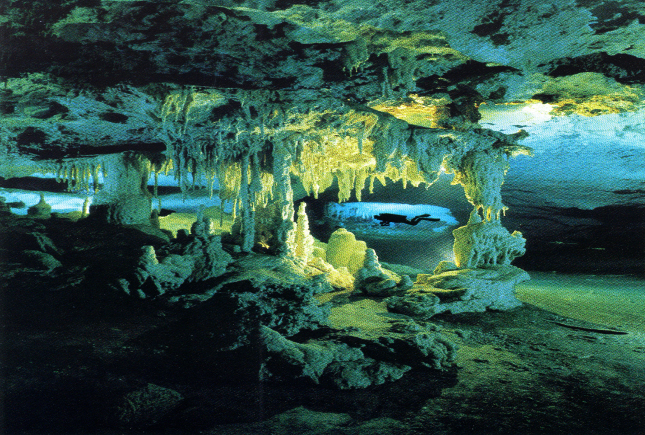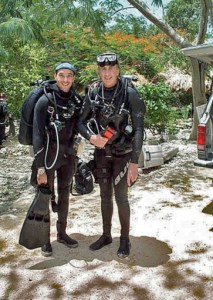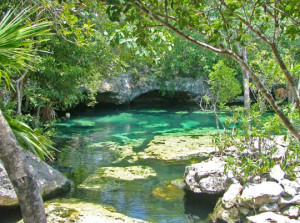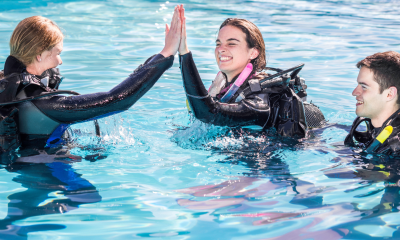Marine Life & Conservation
The Yucatan Cenotes – A paradise under threat from tourism

An interview with Sam Meacham by Jeff Goodman
A few years ago I made a film for the BBC called ‘Secrets of the Maya Underworld’ and was about the Cenotes and forests of the Yucatan Peninsula, Mexico. Previously I had always promised myself not to ever cave dive as I had a fear of being lost or trapped far underground with no escape route. Then a few very good friends told me of the Cenotes and the incredible wildlife that was associated with them. I had to see for myself.
 It was then I met Sam Meacham, an American living near Cancun. He had been exploring the caves and passageways of the Yucatan Peninsula for the previous 18 years and now to date has discovered with other divers 252 known caves and cave systems in that region with a total of 1,103.3 km or 685.5 miles of surveyed passageway between them. Two of the five longest caves on the planet Sistema Sac Actun and Sistema Ox Bel Ha are found close to the town of Tulum.
It was then I met Sam Meacham, an American living near Cancun. He had been exploring the caves and passageways of the Yucatan Peninsula for the previous 18 years and now to date has discovered with other divers 252 known caves and cave systems in that region with a total of 1,103.3 km or 685.5 miles of surveyed passageway between them. Two of the five longest caves on the planet Sistema Sac Actun and Sistema Ox Bel Ha are found close to the town of Tulum.
The Yucatán Peninsula was once a shallow coral reef and now over a few million years has become a porous limestone shelf covered with forest and wildlife. There are no visible rivers; all the fresh water rivers are underground. Being porous, caverns and caves formed where the fresh water collects – hence the Cenotes or water sinkholes.
Recently, the Cenotes have become a great dive destination and the eastern Yucatan coastline an ever developing tourist area for sun worshipers and beach goers. The seemingly uncontrolled developments are taking their toll on this unique ecosystem.
I recently got back in touch with Sam to see if things were improving.
Jeff: Can you just tell us exactly what the Cenotes are and what is so special about them?
Sam: Cenotes are karst sinkholes that occur in Mexico’s Yucatan Peninsula. The Cenotes are windows into the freshwater aquifer of the region and the entrances to the very complex flooded solution cave systems along the Caribbean coastline.
 Jeff: The underground water systems give life to the forests above where wildlife is obvious to find, but is there life in the caves as well?
Jeff: The underground water systems give life to the forests above where wildlife is obvious to find, but is there life in the caves as well?
Sam: Most people think of the cave environment as a very sterile place. In fact, there are over 40 life forms so far identified that live in the dark recesses of these caves. The majority are crustaceans and they are all considered extremeophiles because of the conditions they live in. The Cenotes themselves are also magnets for life; this includes a number of freshwater tropical fish species, crocodiles, turtles in the water and birds and mammals (including jaguars) at the surface.
Jeff: How long has man know about the Cenotes?
Sam: There is growing evidence that the caves and Cenotes were accessed by humans during the last ice age, which was 8000-10000 years ago.
Jeff: Did the Maya have any idea about the complexity of the underground waterways?
Sam: It is hard to say if the Maya realized that some of the Cenotes were connected by the intricate and complex cave systems. Many of the underground rivers flow out to the sea in very impressive upwellings; perhaps they put two and two together when they observed this. It was not until the 1980’s that cave divers really began to probe the depths of the Cenotes and really revealed just how complex and extensive they were.
Jeff: Are the Cenotes and reliant ecosystems in any threat now due to the commercial tourist developments?
Sam: There is a very real and continuing threat from the development of the tourism industry along the coastline. Karst landscapes like the Yucatan are very susceptible to contaminants that leach through the porous limestone and into the aquifer.
Jeff: What are the main issues?
Sam: The main issues we face are contamination from solid waste (garbage) and sewage. Once contaminants hit the aquifer there is the high potential for them to be transported through cave conduits and out to the Caribbean Sea. High concentrations of contaminants cause algal blooms that cover the Mesoamerican Reef and kills the corals. If we lose the reef, we lose the protection to the beaches. If the beaches erode, where will the tourists go? Effectively, we risk killing the goose that lays the golden egg.
Jeff: Is anyone listening to the conservation needs of the area or is commercialism taking its full toll?
Sam: Well, I think worldwide conservation efforts are always facing an uphill battle and this area is no exception. But I do think there is a great deal more awareness about the existence and importance of the flooded caves. My personal belief is that the outreach and education about the caves is the only way we can engage the public and effect change.
Jeff: As Divers, how can we help preserve this unique ecosystem?
Sam: If you dive in the Cenotes, it is a great opportunity to perfect your skills particularly your buoyancy and trim. Really, any time you go diving you should be perfecting your skills. We, as divers, are privileged visitors to the underwater environment and must make every effort to protect it.
Jeff: If readers want to learn more where can they get further information?
Sam: Here are a few websites:
Blogs
Invitation from The Ocean Cleanup for San Francisco port call

6 years ago, The Ocean Cleanup set sail for the Great Pacific Garbage Patch with one goal: to develop the technology to be able to relegate the patch to the history books. On 6 September 2024, The Ocean Cleanup fleet returns to San Francisco bringing with it System 03 to announce the next phase of the cleanup of the Great Pacific Garbage Patch and to offer you a chance to view our cleanup system up-close and personal.
We look forward to seeing you there.
To confirm your presence, please RSVP to press@theoceancleanup.com
PROGRAM
Join The Ocean Cleanup as our two iconic ships and the extraction System 03 return to San Francisco, 6 years and over 100 extractions after we set sail, to create and validate the technology needed to rid the oceans of plastic.
Our founder and CEO, Boyan Slat, will announce the next steps for the cleanup of the Great Pacific Garbage Patch. Giving you a chance to view our cleanup system and the plastic extracted.
Hear important news on what’s next in the mission of The Ocean Cleanup as it seeks to make its mission of ridding the world’s oceans of plastic an achievable and realistic goal.
Interviews and vessel tours are available on request.
PRACTICALITIES
Date: September 6, 2024
Press conference: 12 pm (noon)
Location: The Exploratorium (Google Maps)
Pier 15 (Embarcadero at Green Street), San Francisco, CA
Parking: Visit The Exploratorium’s website for details.
RSVP: press@theoceancleanup.com
Video & photo material from several viewing spots around the bay
We look forward to seeing you there!
ABOUT THE OCEAN CLEANUP
The Ocean Cleanup is an international non-profit that develops and scales technologies to rid the world’s oceans of plastic. They aim to achieve this goal through a dual strategy: intercepting in rivers to stop the flow and cleaning up what has already accumulated in the ocean. For the latter, The Ocean Cleanup develops and deploys large-scale systems to efficiently concentrate the plastic for periodic removal. This plastic is tracked and traced to certify claims of origin when recycling it into new products. To curb the tide via rivers, The Ocean Cleanup has developed Interceptor™ Solutions to halt and extract riverine plastic before it reaches the ocean. As of June 2024, the non-profit has collected over 12 million kilograms (26.4 million pounds) of plastic from aquatic ecosystems around the world. Founded in 2013 by Boyan Slat, The Ocean Cleanup now employs a broadly multi-disciplined team of approximately 140. The foundation is headquartered in Rotterdam, the Netherlands, and opened its first regional office in Kuala Lumpur, Malaysia, in 2023.
Find out more about The Ocean Cleanup at www.theoceancleanup.com.
Marine Life & Conservation
SHARK MONTH ARRIVES AT ROYAL WILLIAM YARD, PLYMOUTH

A shark has been spotted approaching Royal William Yard in Plymouth, much to the surprise of swimmers, paddleboarders and onlookers.
With its distinctive dorsal fin cutting through the water, the sizeable shark swam along the coastline, before turning to head inland towards Firestone Arch at Royal William Yard. The appearance drew a crowd, who were captivated for more than an hour by the unusual sight – and it was all caught on video.
The shark is one of many expected sightings at Royal William Yard over the coming weeks… because today marks the start of Shark Month!
In reality, the ‘shark’ spotted along the Plymouth shoreline was actually a custom-made model, created by the team at Royal William Yard and sailed underwater by Caroline Robertson‑Brown from the Shark Trust, who donned scuba diving gear for the occasion.
The stunt took place to launch Shark Month in style and draw attention to the work of the leading international conservation charity, which is based in Britain’s Ocean City. Spectators were reassured that the water was safe and many entered into the spirit of the performance, swimming or sailing alongside the shark.
Shark Month will take place across Royal William Yard throughout July and will feature an extravaganza of art, entertainment and advocacy for everyone to enjoy. The packed programme of events starts with an art exhibition and ends with a trip on paddleboards with shark experts – with everything from a shark quiz to a Jaws screening in between.
Paul Cox, CEO of the Shark Trust, said: “There are often assumptions and misconceptions when it comes to sharks. This was certainly the case with the shark spotted at Royal William Yard! While the British coastline is home to many species of shark, this was not one of them. However, we’re thrilled it caught people’s attention, because seeing a shark is a special and memorable moment. That is precisely why we want to celebrate these incredible creatures, highlight the need for conservation, and ask for help to safeguard their future.”
For more information about Shark Month at Royal William Yard, visit the Shark Trust Website.
Images and video: Jay Stone
-

 Blogs2 months ago
Blogs2 months agoDiving With… Nico, Ocean Earth Travels, Indonesia
-

 News1 month ago
News1 month agoMurex Bangka Announce New Oceanfront Cottages & Beachfront Dining
-

 Blogs2 months ago
Blogs2 months agoA new idea in freediving from RAID
-

 Marine Life & Conservation1 month ago
Marine Life & Conservation1 month agoIceland issue millionaire whale hunter a licence to murder 128 vulnerable fin whales
-

 Marine Life & Conservation2 months ago
Marine Life & Conservation2 months agoThe Shark Trust Great Shark Snapshot is back
-

 News3 months ago
News3 months agoCharting New Waters; NovoScuba Goes Global with the Launch of their Revolutionary Dive Training Agency!
-

 Gear News1 month ago
Gear News1 month agoNew Suunto Ocean – a dive computer and GPS sports watch in one for adventures below and above the surface
-

 Marine Life & Conservation Blogs2 months ago
Marine Life & Conservation Blogs2 months agoBook Review: Plankton




